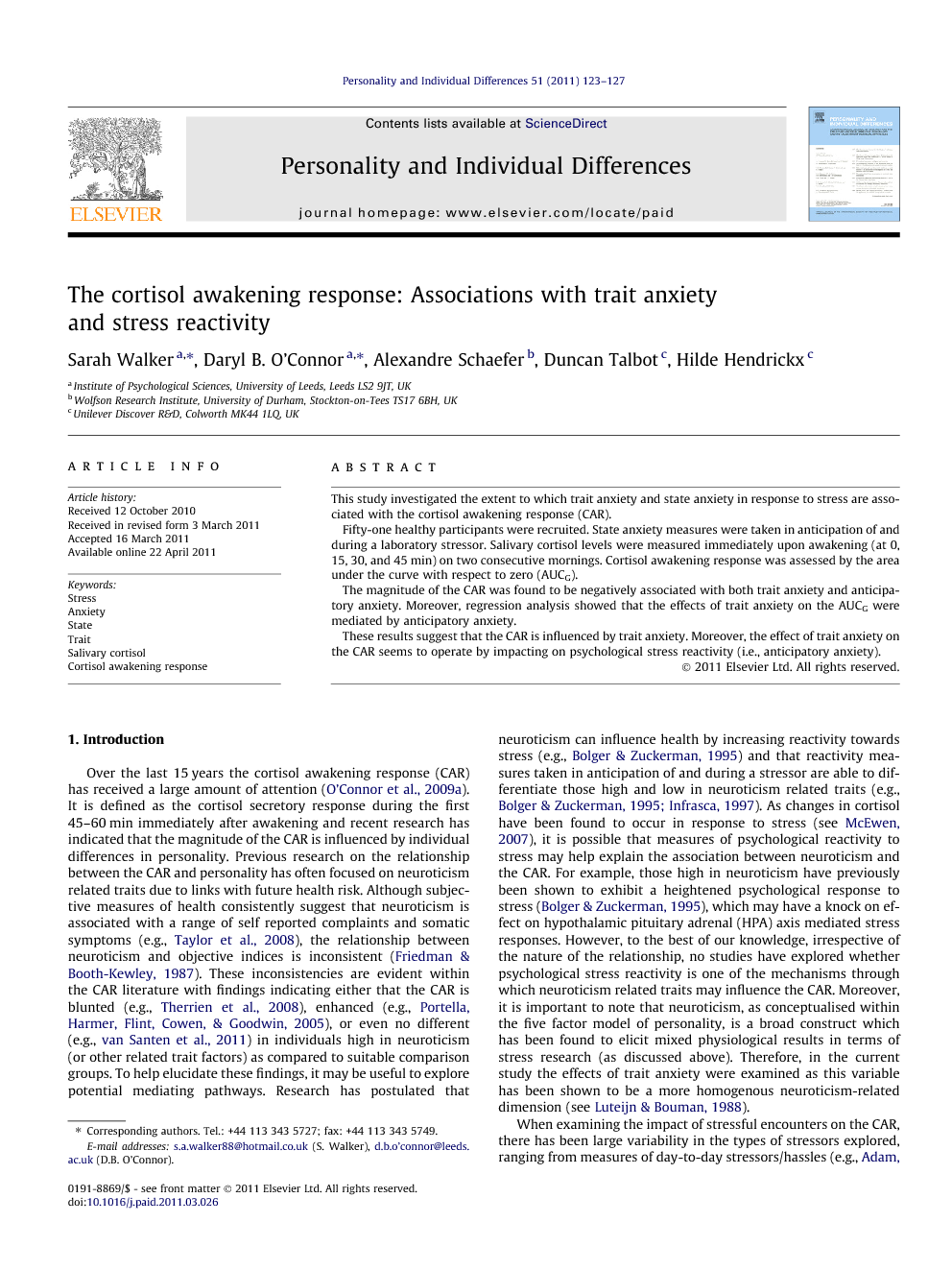Over the last 15 years the cortisol awakening response (CAR) has received a large amount of attention (O’Connor et al., 2009a). It is defined as the cortisol secretory response during the first 45–60 min immediately after awakening and recent research has indicated that the magnitude of the CAR is influenced by individual differences in personality. Previous research on the relationship between the CAR and personality has often focused on neuroticism related traits due to links with future health risk. Although subjective measures of health consistently suggest that neuroticism is associated with a range of self reported complaints and somatic symptoms (e.g., Taylor et al., 2008), the relationship between neuroticism and objective indices is inconsistent (Friedman & Booth-Kewley, 1987). These inconsistencies are evident within the CAR literature with findings indicating either that the CAR is blunted (e.g., Therrien et al., 2008), enhanced (e.g., Portella, Harmer, Flint, Cowen, & Goodwin, 2005), or even no different (e.g., van Santen et al., 2011) in individuals high in neuroticism (or other related trait factors) as compared to suitable comparison groups. To help elucidate these findings, it may be useful to explore potential mediating pathways. Research has postulated that neuroticism can influence health by increasing reactivity towards stress (e.g., Bolger & Zuckerman, 1995) and that reactivity measures taken in anticipation of and during a stressor are able to differentiate those high and low in neuroticism related traits (e.g., Bolger and Zuckerman, 1995 and Infrasca, 1997). As changes in cortisol have been found to occur in response to stress (see McEwen, 2007), it is possible that measures of psychological reactivity to stress may help explain the association between neuroticism and the CAR. For example, those high in neuroticism have previously been shown to exhibit a heightened psychological response to stress (Bolger & Zuckerman, 1995), which may have a knock on effect on hypothalamic pituitary adrenal (HPA) axis mediated stress responses. However, to the best of our knowledge, irrespective of the nature of the relationship, no studies have explored whether psychological stress reactivity is one of the mechanisms through which neuroticism related traits may influence the CAR. Moreover, it is important to note that neuroticism, as conceptualised within the five factor model of personality, is a broad construct which has been found to elicit mixed physiological results in terms of stress research (as discussed above). Therefore, in the current study the effects of trait anxiety were examined as this variable has been shown to be a more homogenous neuroticism-related dimension (see Luteijn & Bouman, 1988).
When examining the impact of stressful encounters on the CAR, there has been large variability in the types of stressors explored, ranging from measures of day-to-day stressors/hassles (e.g., Adam, Hawkley, Kudielka, & Cacioppo, 2006), to psychological responses to laboratory-based stressors (e.g., Fabian et al., 2009). In the present study it was thought important to explore the impact of psychological responses to a laboratory-based stressful event on the CAR in order to standardise the stressful encounter that participants were exposed to. Therefore, here we explored the associations between psychological responses to negative images using stimuli from the International Affective Picture System (Lang, Bradley, & Cuthbert, 1999) and the CAR. In particular, two components of the psychological response to stress were measured (anticipatory anxiety: anxiety in anticipation of the stressor; task anxiety: anxiety during the stressor) as these components have previously been found to be significantly associated with cortisol responses to an acute stressor (e.g., Elzinga, Schmahl, Vermetten, van Dyck, & Bremner, 2003). Exploring the relationship between state anxiety and the CAR was used to provide an index of how someone’s general reaction to everyday stress may impact on cortisol output.
A number of methodological and measurement issues may have accounted for the inconsistencies outlined in the previous personality, stress and CAR research findings. First, participant non-adherence to the sampling protocol is known to be a serious problem in CAR research and the importance of the timing of the samples has been found to be vital (O’Connor et al., 2009a and Thorn et al., 2006). Second, it is essential to control for potential confounding variables. The effects of individual differences such as age, gender, awakening time, depression symptomatology and body mass index (BMI) on the CAR are inconsistent (for reviews see Almeida et al., 2009 and Fries et al., 2009). Moreover the directionality of any observed relationship is difficult to determine due to these mixed results. Nevertheless, the potential explanatory effect of such factors is thought important to consider in any CAR analysis. Therefore, in the current study, we removed participants suspected of non-adherence to the sampling protocol and examined the effects of age, gender, awakening time, BMI and depression symptomatology in all analyses.
In summary, this study had two main aims: (1) to clarify the direction of the relationship between trait anxiety and the CAR, and (2) to explore whether the impact of trait anxiety is mediated through psychological stress reactivity (i.e., changes in state anxiety in anticipation and during a stressor).


